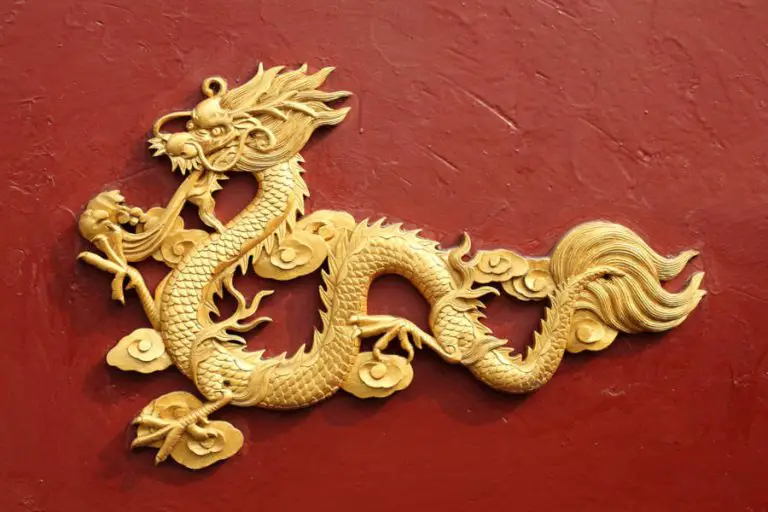Orchids are celebrated worldwide for their stunning beauty and captivating elegance. With their delicate petals and almost mystical forms, orchids capture hearts in every corner of the globe. They are among the most prized flowers for their rarity, diversity, and the refined air they bring to any setting.
Beyond their visual allure, orchids carry deep cultural and spiritual significance, particularly in Chinese culture and Feng Shui, where they embody virtues and values that have been revered for centuries.
In Chinese culture, orchids are not just admired for their beauty; they hold profound symbolic meaning. Ancient scholars and philosophers like Confucius celebrated orchids in poetry and prose, drawing connections between their refined appearance and qualities such as purity, humility, and moral integrity.
Over time, orchids became a symbol of both personal and societal values, and they were often depicted in art and literature to convey these deeper messages. Orchids also play a special role in Feng Shui, where they are seen as bringers of harmony and positive energy (Qi). Carefully placed in the home or workspace, orchids are believed to uplift the environment, inviting balance, prosperity, and peace.
Understanding the symbolism of orchids, and flowers in general, can add a meaningful dimension to our lives. In the art of Feng Shui, every flower has a purpose, and selecting the right one can bring about positive shifts in various aspects of life.
Orchids, with their balanced energy and symbolic purity, can be particularly powerful in enhancing harmony and prosperity. As we explore the layers of orchid symbolism in Chinese culture and Feng Shui, we uncover how these graceful flowers can enrich our surroundings and deepen our connection to timeless virtues.
Orchids in Chinese Culture: A Glimpse into History
Orchids have been deeply intertwined with Chinese culture for centuries, their symbolism celebrated in literature, art, and philosophy.
Ancient Chinese Literature and Orchids
Orchids have held a treasured place in Chinese literature for over two millennia, admired not just as plants, but as symbols of virtue and character. Confucius, one of China’s most influential philosophers, praised the orchid in his writings as a representation of integrity and humility.
For Confucius, orchids growing in wild, remote areas symbolized the virtuous individual who remains true to their principles, even when unobserved or unappreciated by others. The delicate beauty of the orchid stood for a quiet strength—a grace that did not seek attention, but was noticed by those who looked deeply.
He noted that “the orchid grows where others cannot,” emphasizing its resilience and the quiet strength found in humility. This metaphor highlights the association of orchids with integrity and scholarly virtues, qualities that are highly esteemed in Chinese culture.
Other philosophers and poets echoed this sentiment. The revered poet Qu Yuan, for example, extolled the orchid’s beauty in his works, considering it a symbol of nobility and holiness. His deep admiration for orchids laid the groundwork for their cultural significance, intertwining them with ideals of moral character and self-restraint. As a result, orchids became synonymous with the virtues of educated individuals and were often depicted as representations of refined character in poetry and prose.
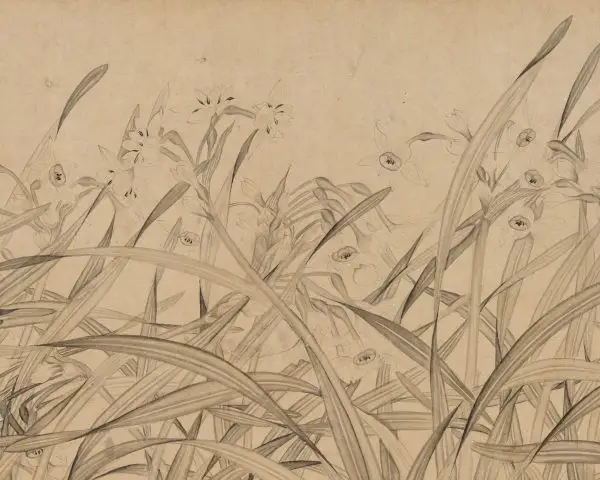
Symbolism of Orchids in Traditional Chinese Art
In traditional Chinese art, orchids are frequently portrayed as symbols of refinement and grace. Artists have utilized these flowers in calligraphy and painting to convey deeper philosophical meanings. The delicate beauty of orchids serves as a metaphor for resilience and grace, capturing the essence of human experience.
For instance, the earliest known orchid painting, created by Zhao Mengjian during the Southern Song Dynasty, illustrates how orchids were not only valued for their aesthetic appeal but also for their representation of emotional depth and cultural ideals.
Orchids are depicted with exposed roots in many artworks to symbolize vulnerability yet enduring strength. This artistic representation reinforces the notion that true beauty often lies beneath the surface, reflecting the complexities of life and human emotion. Through these artistic expressions, orchids have come to embody ideals that resonate deeply within Chinese society.
| Medium | Symbolism of Orchids | Cultural Significance |
| Poetry | Elegance, purity, resilience | Used to symbolize beauty and inner strength in poetry. |
| Calligraphy | Nobility, integrity, moral excellence | Represents the ideal Confucian scholar-gentleman. |
| Painting | Refined grace, resilience | Often depicted with other “Four Noble Plants” to show harmony. |
Cultural Significance of Orchids as One of the Four “Noble Plants”
Orchids hold an especially honored place in Chinese culture as one of the “Four Gentlemen” or “Four Noble Plants,” a group that also includes bamboo, chrysanthemum, and plum blossom. Each of these plants represents virtues valued in Chinese society, and together, they symbolize the spirit of the noble scholar. Orchids are the symbol of spring, freshness, and purity, marking the season of new beginnings and a sense of beauty untainted by the outside world.
The orchid is celebrated as a symbol of purity, beauty, and elegance, representing an ideal of refined, understated nobility. Unlike flowers that demand attention with bold colors or scents, the orchid’s charm lies in its subtlety and natural elegance.
Its modest beauty speaks to a value system that respects quiet strength, and its upright form reflects an unyielding grace, regardless of circumstance. In this way, orchids have become much more than mere flowers; they are cultural icons, inspiring generations to live with integrity, humility, and an appreciation for life’s deeper beauty.
| Plant | Symbolism | Cultural Context |
| Orchid | Purity, beauty, elegance, integrity | Represents moral character and scholarly virtues. |
| Bamboo | Strength, flexibility, resilience | Symbolizes endurance and humility, often used in art to reflect personal growth. |
| Chrysanthemum | Longevity, endurance, autumn | Represents fortitude and nobility, often used during celebrations. |
| Plum Blossom | Renewal, perseverance, beauty | Represents resilience in adversity, often associated with the arrival of spring. |
Related reading: Feng Shui Made Easy: Discover the Power of Succulents in Your Home! – Opens in new tab
Orchids in Chinese Mythology and Folklore
In Chinese folklore, orchids are often linked to the presence of magical beings, particularly the Orchid Fairy, a figure celebrated for her beauty, grace, and gentle nature. The Orchid Fairy is said to embody the soul of the orchid flower itself, radiating elegance and a quiet charm that captivates those around her.
Legends tell of this ethereal figure wandering through secluded valleys and lush forests, where her presence brings harmony to the natural world. Her beauty is not flashy or loud; rather, it is a calm and inviting charm, much like the orchid flower she represents.
The Orchid Fairy symbolizes an ideal of feminine grace and purity, embodying the virtues that the orchid represents in Chinese culture. Known for her kindness and gentle spirit, she is often associated with healing and protection, believed to bless those who encounter her with good fortune.
This connection with luck and serenity has made orchids a popular choice in homes and gardens, where they are thought to invite the graceful energy of the Orchid Fairy, fostering peace and calm within the environment. The story of the Orchid Fairy brings a sense of wonder to the flower, inviting admirers to see beyond its physical beauty and connect with its deeper, mystical qualities.
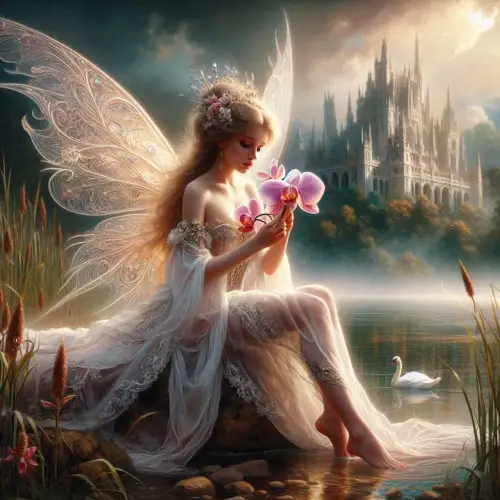
Orchids and Immortality: A Connection to the Divine
Orchids also carry profound associations with immortality and spirituality in Chinese mythology. In many ancient texts, they are revered as symbols of eternal life and divine connection. The delicate blooms are often linked to celestial beings, suggesting that they bridge the gap between the earthly realm and the divine. This belief stems from their ability to thrive in various environments, symbolizing resilience and the continuity of life.
In some legends, orchids are said to bloom in sacred places where spirits reside, further emphasizing their connection to immortality. They are often depicted in art alongside deities or used in rituals aimed at invoking blessings from higher powers. The belief that orchids can attract positive energy (Qi) enhances their role as conduits for spiritual growth and enlightenment.
Furthermore, orchids are sometimes associated with specific immortals in Taoist mythology, who are believed to favor these flowers for their purity and elegance. This association elevates orchids beyond mere plants; they become symbols of aspiration towards a higher state of being, encouraging individuals to seek wisdom, virtue, and ultimately a connection with the divine.
Feng Shui and Orchids: Inviting Harmony and Prosperity
Orchids are not only aesthetically pleasing but also powerful tools in Feng Shui, the ancient Chinese practice of arranging spaces to harmonize with the flow of energy, or Qi.
Understanding Orchids’ Role in Feng Shui Practices
Orchids play a significant role in Feng Shui, embodying essential principles of balance and harmony. Their graceful appearance and vibrant colors are believed to create a serene atmosphere, promoting a sense of well-being in any space. In Feng Shui, orchids are valued for their ability to attract positive energy (Qi), which is vital for enhancing the overall energy flow in homes and workplaces. Placing orchids strategically can help cultivate an environment that supports prosperity, creativity, and emotional balance.
The delicate beauty of orchids also symbolizes refinement and elegance, qualities that resonate with Feng Shui ideals. By incorporating these flowers into your decor, you not only enhance the aesthetic appeal of your space but also invite a sense of tranquility and positivity. This dual role makes orchids a popular choice for those looking to harmonize their surroundings while also expressing their personal style.
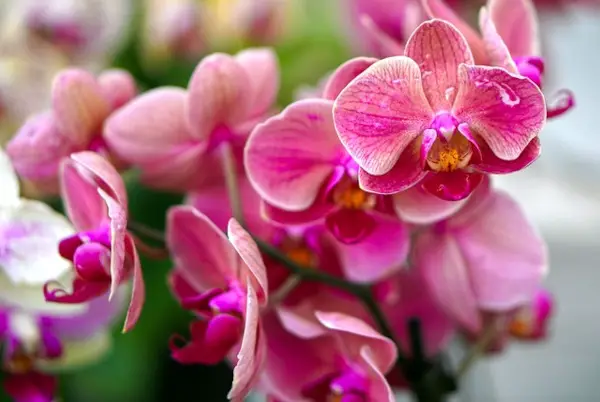
Orchids and the Five Feng Shui Elements
In Feng Shui, understanding the Five Elements—Wood, Fire, Earth, Metal, and Water—is crucial for creating a balanced environment. Orchids can be strategically placed according to these elements to maximize their positive effects:
- Wood: Representing growth and vitality, orchids naturally align with the Wood element. Incorporating green or blue orchids can enhance this energy, making them ideal for areas where you seek new beginnings or personal development.
- Fire: The vibrant colors of orchids can also correspond with the Fire element. Red or orange orchids can stimulate passion and creativity, making them suitable for spaces where inspiration is needed.
- Earth: Earthy tones such as yellow orchids resonate with stability and grounding. Placing yellow orchids in living rooms or communal areas fosters a sense of support and connection among family members.
- Metal: White or pale-colored orchids symbolize clarity and precision associated with the Metal element. These colors can enhance focus and organization in workspaces.
- Water: Dark blue or black orchids evoke the Water element’s qualities of wisdom and intuition. They are perfect for areas where reflection and calmness are desired, such as meditation spaces.
How Orchid Colors Correspond with Feng Shui Elements to Influence Life Areas
The color of orchids plays a significant role in Feng Shui, influencing specific aspects of life according to the principles of color energy. Here’s how different orchid colors impact Feng Shui:
- White Orchids: White orchids signify purity, peace, and spiritual growth. They are best suited for spaces meant for rest, meditation, or self-reflection, such as bedrooms or quiet corners of a home. White orchids support clarity and are ideal for grounding oneself spiritually.
- Pink Orchids: Representing love, compassion, and gentle energy, pink orchids are often placed in bedrooms or family areas to promote harmony and emotional warmth. They are especially effective in enhancing romantic relationships and deepening emotional bonds within a family.
- Purple Orchids: Purple orchids are symbols of wealth, nobility, and respect. They bring a luxurious energy that supports aspirations for financial success and personal growth. Placing purple orchids in the wealth corner of a home (southeast) encourages prosperity and can elevate the energy of any space.
- Yellow Orchids: Known for their association with creativity, communication, and new beginnings, yellow orchids are wonderful additions to workspaces or social areas. They invite a sense of joy and innovation, making them perfect for offices, study rooms, or areas where fresh ideas are needed.
- Red Orchids: Red is a vibrant color tied to passion, vitality, and enthusiasm. Red orchids bring a lively energy to spaces, making them well-suited for creative studios, home offices, or areas where motivation and focus are key. They can also enhance romantic energy when placed in bedrooms.
| Orchid Color | Symbolism | Feng Shui Application |
| White | Purity, peace, spiritual growth | Ideal for bedrooms to promote tranquility |
| Pink | Love, compassion | Great for romantic spaces |
| Purple | Wealth, respect | Suitable for home offices to attract prosperity |
| Yellow | Creativity, communication | Good for creative workspaces |
| Red | Passion, vitality | Enhances energy in social areas |
Want to learn more about Feng Shui? Take a look at these Courses and Books – Aff.link
The Symbolism of Orchids in Personal Life and Relationships
Orchids are not only beautiful to behold but also carry profound symbolism in personal relationships and life events.
Orchids as Symbols of Love and Friendship
Orchids are profound symbols of love and friendship, cherished for their elegance and beauty. Gifting orchids is a meaningful gesture that signifies admiration, loyalty, and a deep connection between individuals. In Chinese culture, the act of presenting orchids conveys a message of respect and appreciation, making them a popular choice for romantic occasions, anniversaries, and celebrations of friendship.
Different types of orchids carry specific meanings in romantic relationships. For instance, Phalaenopsis orchids, often referred to as “moth orchids,” symbolize enduring love and beauty. Their long-lasting blooms reflect the strength and resilience of a relationship, making them an ideal gift for couples celebrating milestones together. Similarly, Cattleya orchids, known for their striking appearance, represent passion and sensuality, embodying the intense emotions often found in romantic partnerships.
The allure of orchids lies not only in their visual appeal but also in their ability to express complex feelings that may be difficult to articulate. By choosing orchids as gifts, individuals can convey sentiments of rare and precious love, making these flowers a timeless choice for expressing deep affection.

Orchids in Family and Community Bonds
Beyond romantic relationships, orchids play a significant role in fostering family unity and community bonds. In Chinese culture, they symbolize harmony and mutual respect among family members. Orchids are often featured in family gatherings or celebrations, where they serve as reminders of the importance of togetherness and support.
During special occasions such as weddings or festivals, orchids are commonly used to symbolize prosperity and peace. Their presence at these events reflects the collective hopes for a harmonious future. For example, during traditional Chinese weddings, orchids are often incorporated into floral arrangements to signify the beauty of marital unity and the couple’s shared aspirations.
In community settings, gifting orchids can also serve as a gesture of goodwill and friendship. Their elegant appearance makes them suitable for various social occasions, reinforcing connections among friends and neighbors. By sharing orchids during gatherings or celebrations, individuals express their desire for lasting relationships built on respect and admiration.
| Orchid Type | Meaning | Ideal Occasions |
| Phalaenopsis | Enduring love | Anniversaries, weddings |
| Cattleya | Passion and sensuality | Romantic gestures, date nights |
| Dendrobium | Friendship and admiration | Gifts between friends or colleagues |
🍀 Our “Feng Shui Master” app is your trusted companion, offering a useful guide to implementing Feng Shui principles. Try it now!
Orchid Placement Tips for Enhanced Feng Shui
To maximize the positive energy of orchids in your home or workspace, consider these Feng Shui placement tips:
Best Locations for Orchids at Home
Where you place orchids in the home can greatly influence the type of energy they bring into your life. Orchids, with their calm yet vibrant presence, can enhance prosperity, focus, and harmony when thoughtfully placed in areas where they best complement the space’s purpose.
- Living Room: Placing orchids in the living room welcomes prosperity and uplifting energy into the home. A well-positioned orchid in this social space brings a warm and positive atmosphere, encouraging open communication and strong family bonds. Orchids in soft hues, such as white or yellow, are ideal in the living room to create a calm yet inviting environment.
- Study or Home Office: The study or home office is a space that benefits from focus and clarity. A white or purple orchid in the east or southeast corner of the study can help boost concentration and enhance mental clarity. These placements encourage productivity and support personal and professional growth, providing a sense of calm that aids focus during work or study sessions.
- Bedroom: Orchids can bring a soothing, romantic energy to the bedroom. Pink and red orchids, in particular, are ideal for enhancing romantic energy and deepening emotional connections between partners. Placed on nightstands or in the southwest corner, these orchids create a harmonious, loving atmosphere that supports intimacy and emotional warmth.
Orchids in Office Spaces for Career Success
Orchids are also powerful additions to office spaces, where they are believed to boost creativity, focus, and overall professional success. Incorporating orchids into a workspace can uplift the energy of the environment, fostering positivity and enhancing one’s reputation and networking prospects.
- Placement for Career Growth: In an office setting, placing an orchid in the southeast corner can stimulate prosperity and growth, which is particularly useful in a career context. Purple or blue orchids work well in this area, as they represent both success and wisdom. Placing an orchid near the entryway or on a desk where it is easily visible can also inspire focus and clarity throughout the workday.
- Suggested Colors for Success: White orchids bring clarity and refinement, making them well-suited for networking and building professional connections. Yellow orchids support creativity and can encourage innovative ideas, making them an excellent addition to collaborative workspaces or meeting rooms. The vibrant energy of red orchids can bring a boost of confidence and enthusiasm, particularly beneficial for individuals in leadership or creative roles.
| Feng Shui Life Area | Best Orchid Placement | Orchid Color Recommendation |
| Wealth (Southeast) | Living room, dining room | Purple or red orchids for financial prosperity |
| Love (Southwest) | Bedroom, relationship corner | Pink orchids to enhance romantic energy |
| Health (Center) | Central space, home entrance | White orchids to promote health and balance |
| Career (North) | Home office, entryway | Yellow or white orchids for career success |
| Creativity (West) | Office desk, creative spaces | Yellow or orange orchids to boost creativity |

Orchid Care and Feng Shui: Importance of Health and Vitality
In Feng Shui, the vitality of plants mirrors the energy they bring to a space, making it essential to care for orchids with attention and intention. A thriving orchid radiates positive energy, symbolizing health, growth, and prosperity, whereas an artificial or wilted plant does not carry the same life force and can even hinder Feng Shui goals.
- Nurturing Positive Energy: Healthy, well-cared-for orchids represent nurturing and patience, two qualities that bring harmonious energy into the home or office. Tending to orchids as living beings not only boosts their health but also creates an environment of respect for nature, reinforcing a space filled with balanced, positive energy.
- The Power of a Thriving Orchid: A flourishing orchid, with its vibrant blooms and lush leaves, signifies life, resilience, and an ability to adapt to its surroundings. This vitality is a powerful reflection of personal growth and abundance, enhancing the energy within the room. In contrast, wilted or neglected plants can bring stagnation, so it’s essential to ensure the orchid’s well-being through regular care.
Using Orchid Symbolism for Personal Growth and Reflection
Orchids, with their delicate beauty and resilience, offer valuable lessons for personal growth and spiritual development.
Meditative Qualities of Orchids in Chinese Philosophy
Orchids possess profound meditative qualities that inspire inner reflection and self-discovery. Their elegance and delicate beauty serve as reminders to pause and appreciate the subtleties of life. In Chinese philosophy, orchids symbolize virtues such as integrity, humility, and self-worth—qualities that encourage individuals to cultivate a deeper understanding of themselves. The sight of an orchid can evoke a sense of tranquility, prompting introspection and a connection to one’s inner self.
The graceful form of orchids teaches us about balance and harmony. Much like the orchid’s symmetrical petals, we are reminded to seek equilibrium in our lives. This balance between our material pursuits and spiritual growth encourages us to reflect on our priorities and aspirations. By embracing the calming presence of orchids, we can foster an environment conducive to personal growth and enlightenment.
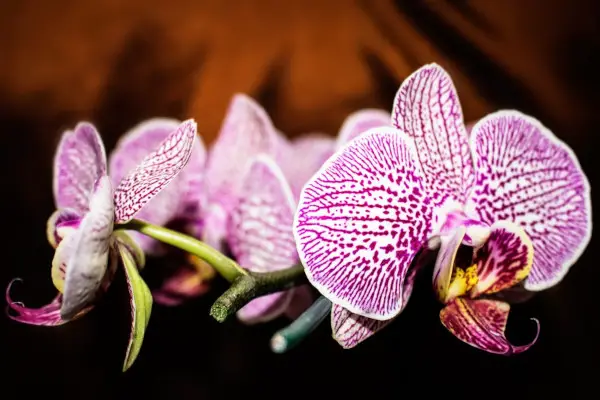
Personal Growth Lessons from the Orchid’s Life Cycle
Observing an orchid’s growth offers valuable lessons in resilience and adaptability. Orchids thrive in diverse environments, from tropical rainforests to rocky cliffs, showcasing their remarkable ability to flourish under varying conditions. This adaptability serves as a powerful metaphor for our own lives, reminding us that we too can thrive amidst challenges and changes. Just as orchids require time and care to bloom, we must nurture our personal development with patience and persistence.
The life cycle of an orchid encourages us to embrace transformation and the natural cycles of life. Each phase—from budding to blooming—represents a journey of growth that requires patience and acceptance. Orchids teach us that setbacks are part of the process; they remind us that true beauty emerges from resilience. By observing how orchids adapt to their surroundings, we can learn to embrace change as an opportunity for growth rather than a hindrance.
Final Thoughts
Orchids are more than just stunning flowers; they embody a rich tapestry of meanings and symbolism that resonate deeply within Chinese culture and Feng Shui practices. From their historical significance in literature and art to their role as symbols of love, friendship, and personal growth, orchids inspire us to appreciate beauty in both nature and our relationships.
Incorporating orchids into our homes and workplaces can enhance harmony, attract positive energy, and foster personal reflection. Their presence encourages us to cultivate virtues such as patience, humility, and resilience—qualities essential for navigating life’s challenges. By understanding the symbolism of orchids, we can create environments that not only reflect our aesthetic tastes but also support our emotional and spiritual well-being.
As we embrace the lessons that orchids offer, we are reminded to celebrate the beauty of transformation and the importance of nurturing connections with ourselves and others. Whether through thoughtful placement in our living spaces or by recognizing their deeper meanings, orchids enrich our lives in countless ways, inviting us to flourish alongside them.
Thank you for exploring the fascinating world of orchids in Chinese culture and Feng Shui. May these exquisite flowers inspire you on your journey toward harmony, prosperity, and personal growth.
Want to learn more about Feng Shui? Take a look at these Courses and Books – Aff.link
Stay in Touch
 Join our newsletter by using the forms on this website or click here!
Join our newsletter by using the forms on this website or click here! Follow us on Google News
Follow us on Google News Follow us on Facebook
Follow us on Facebook
Featured Photo by Man Dy



